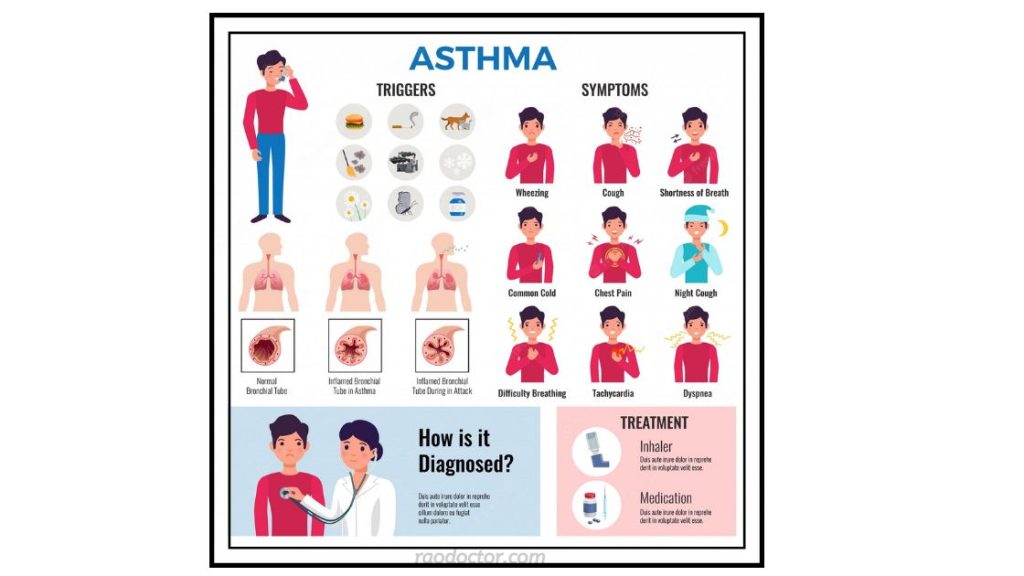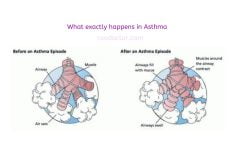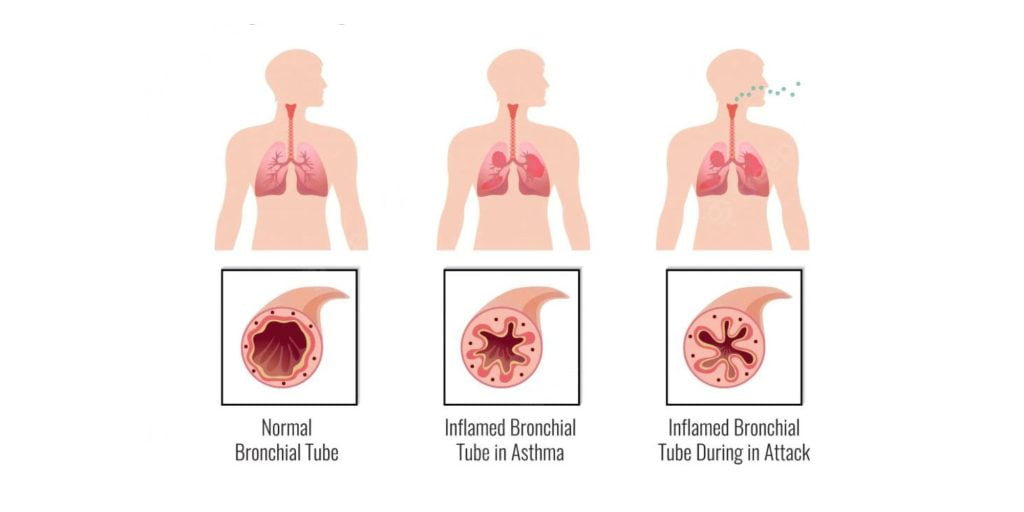6 things About Bronchial Asthma You should know and how to treat it for good health
Bronchial asthma is a chronic inflammatory disease of the airways. It is the most common type, affecting more than 300 million people worldwide. It is triggered by exposure to certain triggers like pet hair, pollen, mold, cigarette smoke, and some other indoor and outdoor allergens. The symptoms include an itchy or scratchy throat, persistent cough, and wheezing after overexertion.

Image Source: FreeImages
If you are not sure if your symptoms point to bronchial asthma, read on. This article will give you detailed information about the condition so you can take the necessary steps towards diagnosis and treatment.
Table of Contents
What Causes Bronchial Asthma?
Asthma is an autoimmune condition that can affect people of all ages. It occurs when your airways become inflamed and narrowed, leading to shortness of breath and chest discomfort. This can happen either when you are exposed to certain allergens or when your immune system becomes overactive. The picture below shows how your bronchi in your lungs go into spasm on exposure to something to which is body is allergic to-
While triggers for asthma vary from person to person, they often include indoor allergens like mold and dust mites, pet dander and hair, cockroach droppings, and other allergens like pollen. Outdoor allergens like pollen, mold spores, and certain chemicals used for swimming pools and landscaping can also trigger it.
The condition is more common during allergy seasons as the air often contains higher levels of allergens than usual. Other risk factors for condition include smoking, a family history of the condition, and having a low birth weight or being born prematurely.
Types of Bronchial Asthma
The most common types of bronchial asthma include –
- Allergic Asthma – It is triggered by allergens in the air or certain foods. It is the most common type and is often managed with anti-allergy medications.
- Exercise Induced asthma- is triggered by exercise or overexertion and is usually managed by resting and drinking water.
- Intrinsic – It is a rare type of condition where the airways are always narrowed, regardless of the presence of is triggered by allergens in the air or certain foods.
- Eosinophilic Asthma- this is type of asthma that has been triggered by allergens with a rise in eosinophil count. The patient typically is woken up at night daily with a bout of uncontrollable cough and wheezing disturbing his sleep.
Risk Factors for Developing Bronchial Asthma
The risk factors for developing a milder form of asthma include having a family history of the condition, a low birth weight, and being a smoker. If you have this disease, there is a higher chance of you may be having allergies such as hay fever as well. The risk factors for developing a more severe form of the condition include having atopy, being overweight, having a family history of allergies, and being exposed to secondhand smoke [as in cigarette smoking].
Symptoms of Bronchial Asthma
The symptoms of bronchial asthma include an itchy or scratchy throat, persistent cough, and wheezing after overexertion. These symptoms can also be a sign for other diseases like rhinitis, gastroesophageal reflux disease, and COPD.

If your symptoms are accompanied by a constricted airway, you might be suffering from bronchial asthma. If you feel any of these symptoms, you can consult a doctor to get a proper diagnosis.
Since the symptoms of this disease are also common in COPD, it is important to see your doctor to rule out any other diseases.
An allergist can also help you identify the triggers of your asthma and prescribe medication to manage the condition.
Diagnosing Bronchial Asthma

If you think you might be suffering from bronchial asthma, the best way to diagnose the condition is by visiting a doctor. He or she will ask you about your medical history and symptoms, as well as test your breathing for abnormalities. These tests are-
- Peakflowmetry
- Spirometry
- Chest X-ray to rule out pneumonia
- Brochoscopy if the symptoms are not getting reversed by treatment.
These tests can help rule out other conditions like allergies or the one caused by COPD. Your doctor may also perform a test called a sputum analysis, in which they test the mucus found in your lungs. This can be used to determine the level of eosinophils ( pulmonary eosinophilia) in your system.
What happens during an asthmatic attack?
During an asthmatic attack, the small tubes called bronchi in your lungs undergo spasm and constriction causing narrowing of the airways. This gives rise to breathlessness [see the picture no. 2 above and below]
Signs of Asthma
The most common sign of asthma is breathlessness and wheezing. Wheezing is a sound you get to hear when your bronchi goes into a spasm due to one of the triggers mentioned above. It is similar to a sound that you get while blowing through a narrow pipe, only that it is a harsh sound.
Treatment of Asthma-How to Manage Your Symptoms and Avoid Triggers
If you are diagnosed with mild bronchial asthma, you can manage your symptoms with lifestyle changes, medication, and regular follow-up visits with your doctor.
You should avoid triggers like cigarette smoke, chemicals, and allergens. Additionally, you can use anti-allergy inhalers and sprays to keep symptoms under control.
Long-term medication is another common treatment used to manage symptoms of asthma. It is a condition that can be managed with lifestyle changes and medication.
You can also make adjustments to your environment to avoid triggers like allergens. If you feel that your asthma is not under control, see your doctor to discuss treatment options.
Asthma Medicines
A variety of medicines are available to control and relieve symptoms of asthma. There is no cure as such, but bronchial asthma can be controlled by using these medications known as bronchodilators–
- Deriphyllin
- Salbutamol- e.g. Asthalin
- Terbutaline-e.g. Brozedex, Grilintus BM
- Ambroxal- e.g. Ambrolite-S syrup, Pulmoclear Syrup
- Bromhexine- e.g. Bromex, Mucospel
- Steroids like dexamethasone, prednisone, beclamethasone
- Anti- allergic medicines like monteleukast, fexofenadine, cetrizine
- Sometimes a drug called Hetrazan ( diethylcarbamazine) is used to overcome eosinophilia.
- Different types of inhalers like salbutamol, salmetrol, budametasone, formetrol,etc.
- Nebulization with medicines same as the inhalers.
A video on Nebulization :-
Here is a short video to help you get proper nebulization-
Your personal physician is the right person to know and help you out with these medicines.
A video on how to manage asthma-
Here is a short video that will help you manage asthma-
Complications of Asthma-
Uncontrolled bronchial asthma can cause a condition called Status Asthmaticus– a condition leading to severe breathlessness with a significant drop in oxygen level (SpO2). This condition needs hospitalization and oxygen administration.
Poor control of acute bronchial asthma can lead to becoming chronic ultimately causing COPD. Here, the patients needs to carry their inhalers wherever they go, because a slight change of atmospheric conditions can trigger an acute attack.
Conclusion
Asthma is a condition that affects millions of people each year. It is characterized by inflammation of the airways, causing difficulty breathing and shortness of breath. While there is no known cure for this disease, it can be managed with lifestyle changes and medication. If you think you might be suffering from asthma, see a doctor to get a proper diagnosis and learn how to manage your symptoms.






